DISPLAY RITUALS and SAFETY
This page is still being developed. So it's a bit rough in some places, but the ideas are new, so they're well worth reading.
Parent Page : Beliefs and Safety.
Safety and Display among Animals
Safety Avoids Display
I don't know enough about various animal behaviours to fill in all the gaps, but the general picture is clear: among animals, safety, especially among vulnerable animals, avoids display.A vulnerable animals' main concern about its own appearance, when wanting to be safe, is to be invisible, they don't call attention to themselves.
Safety Measures
The mouse freezes, playing dead to avoid the snake seeing it.Staying still is the best way to avoid being seen by any panarally aware predators.
 Invisibility is often enhanced by evolution with camouflage.
Invisibility is often enhanced by evolution with camouflage.
 Occasionally animals camouflage at the same time as moving; as in the woodcock's dance, which would probably look like a bundle of leaves to a
Occasionally animals camouflage at the same time as moving; as in the woodcock's dance, which would probably look like a bundle of leaves to a
Hedgehogs are good examples of creatures who rely on their spikes (defence weapons) to deter predators, incidently they make a lot of noise which often scares even humans when they hear it the first time. The coala bear eats so many eucalyptus leaves that it is lethally poisonous to predators.
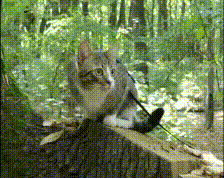 Generally, when they are still, animals are less easy to see by humans, cats, and dogs with their ability to focus – and are almost impossible to detect by panaral predatory animals.
Generally, when they are still, animals are less easy to see by humans, cats, and dogs with their ability to focus – and are almost impossible to detect by panaral predatory animals.
Animal Display Rituals
Some birds have evolved to permanently display colours contrary to all the normal rules of camouflage. Presumably among species who can quickly escape to trees, social cohesion outweighs invisibility.Panaral activity is almost impossible at the same time as conscious display. Here, display is a focused activity, and it's designed to be focused on by others.
 Animals normally display on specific occasions to do with courtship rituals, social rank, and territorial behaviours. Display is made with the explicit intention of being noticed, recognised, and affirmed.
Animals normally display on specific occasions to do with courtship rituals, social rank, and territorial behaviours. Display is made with the explicit intention of being noticed, recognised, and affirmed.
Once social roles and territory are established, display is not constantly necessary. It is only used for re-confirmation and this behaviour is ritualised.
Many animals have a morning self-assertive display ritual, to re-establish territorial security with neighbours.
The behaviour is ritualised to save time for the material challenges of life.
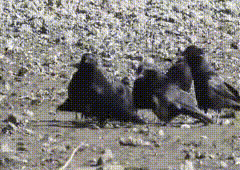 Display rituals occasionally involve group confirmation. Crows bowing to each other is a good example. Such mutual displays of internal group confirmation are very rare among animals.
Display rituals occasionally involve group confirmation. Crows bowing to each other is a good example. Such mutual displays of internal group confirmation are very rare among animals.
Mutual confirmation 'dances' are common among humans.
Threat and Defence Display
Predatory animals attacking are not displaying, the tiger is deadly serious.Large animals like elephants, rhinos and giraffes can't hide, and typically they make aggressive displays when threatened. Even horses make defence displays.
But in the animal world such displays are infrequent and avoided whenever possible.
Humans have developed some of these threat defence display behaviours, adapted them to words, and use them ritually, socially and psychologically.
Looking at human psychological behaviour from the perspective of animal behaviour is fascinating. Early childhood experiences of defence-attack situations form the basis of our ritualised adult identity display.
Human Display Behaviour
The Parent Page Beliefs and Safety discusses how humans look for a feeling of safety by focusing on ideas, opinions, and beliefs.
At the end of Beliefs and Safety, The Craziest of Animals introduces and summarises how humans even display in order to find safety.
Humans Display For Safety
Modern human display behaviour is an incredibly complex subject. There are libraries full of theories and ideas about the subject.I found it refreshing to think about it from the perspective of animal behaviour.
Traditionally we all believed the same thing and danced the same way, copied each other, and wore the same clothes. We were a mirror to each other. The display worked because we all played the same game. And the display was ritualised.
These days our feeling of identity is still primarily based on our beliefs and world view. And though we don't all speak the same language anymore, we still express ourselves by the way we dance and vocalise with each other when we meet – much like birds and frogs.
And most of the practical forms of our self-expression, our clothes, music, and language, can be traced to animal behaviour.
But i notice something remarkable and peculiar to humans, something almost unknown in the animal world, the display of belongings.
Previously we belonged together. Nowadays, our belongings are where we feel we belong... we identify with our belongings... we display with our belongings.

Bags and Belongings
The only comparison with humans and their belongings are otter's and their play-stones.Otters get attached to special stones and keep them in pockets of skin under their arms.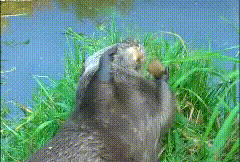
Otters' play is not a display. It is not done for the purpose of being seen. It seems to be done for personal pleasure, maybe a form of otter ergotherapy or chi-gong.
Various animals play with human toys; balls are especially popular. But otter's stones are a naturally occurring toy, arguably in use even before humans existed. And this toy seems to be a unique example of a naturally occurring material possession.
This suggests a surprising start to the story of material belongings: fun or ergotherapy.
Marsupials like kangaroos are known to carry food temporarily in their pouches, but there appears to be no record of marsupials using tools or naturally occurring toys.
Belongings are very rare among animals. The primary reason for this seems obvious – because carrying them around is impractical.
Even in primitive times, humans could make bags. Humans could carry a spear on a strap slung over their shoulders, but small knives, fire stones, dried herbs and roots needed bags.
The point is, no other animal has ever thought of making bags to carry things in and to turn them into belongings and possessions.
This initiated a new level of self-identity. Humans started developing a sense of identity with their belongings unlike any other animal except otters.
This in turn added a totally new dimension to human behaviour. How we built our nests and burrows with our belongings, how humans identify and display with their belongings, and how we arrange our lives around our belongings.
Looking at behaviour from this perspective has consequences, which involve new ideas every time i look and rethink it.
The next factor which is unusual in the animal world, is transport.
Transport
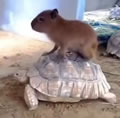
 The way humans transport themselves is not unique.
The way humans transport themselves is not unique.
There are various examples of animals using other animals for transportation. 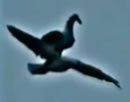 The capybara is master of this life-style.
The capybara is master of this life-style.  (It is worth noting that all these pictures were taken before AI.)
(It is worth noting that all these pictures were taken before AI.)
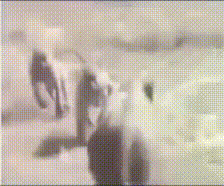 But no other animal makes bags, so they don't have possessions to transport, and this has immense consequences.
But no other animal makes bags, so they don't have possessions to transport, and this has immense consequences.
Only humans made bags, then we trained camels, horses and donkeys, to carry the bags. Then came the wheel and horses to pull boxes. We know the story. But first we needed bags.
Direct Connections with Animal Behaviour
 There are obvious connections between courtship rituals and the development of modern human clothing. And psychologically speaking, deceit and even self-deceit have often been compared to animal behaviour with camouflage.
There are obvious connections between courtship rituals and the development of modern human clothing. And psychologically speaking, deceit and even self-deceit have often been compared to animal behaviour with camouflage.There are even vague connections with tools and weapons. Some monkeys throw objects at humans. But i doubt if any over-populated ape species has ever collected arsenals in preparation. The accumulation of an arsenal is an offshoot of belongings.
And then, there are obvious connections between nests, burrows, and human houses. But in modern times, solid walls have led to another new peculiar human behavioural development.
Walls and Privacy
One of the few special times when we don't display is when we are in private, secure in our own walls.What is this human sense of privacy? Every rabbit in its burrow, every bird in its nest, shares it with family. Animals don't know privacy.
We don't display is when we are in the privacy of our own walls. We may witness and enjoy our own display of our belongings.
And this phenomenon is only apparent in the modern world, Third World countries still share family rooms. Perhaps the almost permanent display in modern life is why individual rooms and having 'my own space', are so important?
Sometimes being in my own space is a time to prepare and practice for the next display.
This idea is developed in Walls and Privacy.
Life is Not a Game
Human display behaviour is well recognised and even socially validated, it's confirmed and even encouraged.There's a long tradition of well-meaning poets and philosophers who maintain life is a game, an illusion or delusion.
Talented poets and philosophers are often good at displaying. They have not realised that animals aren't playing a game. Animals often get eaten alive, it's not an illusion or a dream – animals have to be still and silent and use their panaral senses to feel safe and to survive.
Anyone who maintains life is a play, a dream, or an illusion, has never experienced panaral reality. They have never realised how their own senses have deceived them into a one-sided focused perspective.
Modern human play is often display and not something we should celebrate, it's largely a symptom of insecurity.
This idea is developed in Life Is A Game.
3 Sub-pages
Life is a Game
The Development of Individual Clothing
Walls and Privacy
Discussion
Our traditional and modern display behaviours, identities, and belief systems developed mutually and synchronically with our environments, clothes, food and recipes, tools, toys, dances, music, language and stories.Added to these, modern humans display with their belongings. They have developed a special relationship with belongings. Often the boundaries between belongings, identity, and practical essentials are blurred. For example with relationships and children, and cars and even bicycles.
This development is consistent with the accumulation and acceleration witnessed in all human behaviour. It involves a continuous increase of things to learn and repeat.
All other animals repeat instinctive behaviour – instinctive behaviour repeats without hardly any built in accumulation or acceleration.
Our abstract self-image has always needed projection and recognition in someone else's 'mirror' to feel recognised and real.
In traditional times human display behaviour worked in a healthy way, the display and celebration of our common identity was ritualised and limited to specific times. Similar to animal behaviour.
But the curious and confused modern human is now in a state of regular, sometimes even permanent display. And endless ideas circle like vultures planning the next display. Our modern almost continuous display is a symptom of our insecurity.
Especially due to competition and lack of unity in the modern world, we compensate our insecurity with display. In modern times, human displays are becoming increasingly dramatic. We are over-displaying.
This is the social image which our sociological sciences tells us is necessary to have confirmed in order to be psychologically healthy.
Humans don't understand the value of being still and panaral.
Humans are only still without any display, when meditating or being entertained by someone else who is displaying, and in these situations we are usually focusing intensively. The privacy of our own room is a time to recuperate, ready for the next display. Sleeping is probably the only exception.
Insecurity
The need for extreme displays is a symptom of our insecurity.Since mating behaviour ceased to be ritualised, becoming acceptable anytime, display behaviour is especially evident among young humans – and then lessons learnt young, often last a life long.
We hardly realise it because it's so automatic and everyone else is displaying as well, it's normal, (or we've given up, it's too much work, so we've become lazy or drunk or alone).
Some people just want to look and act normal, don't like being centre of attention, (but at the same time don't want to feel left out). Though this appears to replicate animals staying still for safety, humans wanting invisibility is often connected with a lack of confidence in their ability to display. I believe at some time, everyone wished they could become a pop star.
People in poverty don't display. Some of these can only dream of a time when they have enough to eat, let alone be able to participate in the privileged land of plenty and able to join in the show.
But, it seems that what we witness as ego-display is based on insecurity.
3 Sub-pages
Life is a Game
The Development of Individual Clothing
Walls and Privacy
Back to Chapter Three : Civilisation's Habitual Ruts
Back to THE PANORAMA SENSES Priority Pages